Mastering Color Psychology for Interiors: The Ultimate Guide
Welcome to "Mastering Color Psychology for Interiors: The Ultimate Guide." In this comprehensive guide, we will delve into the fascinating world of color psychology and its profound impact on our mental well-being in interior design. From understanding the emotional impact of colors to choosing the perfect hues for a peaceful home, we will explore the transformative power of color therapy in creating harmonious and inviting spaces.
Introduction to Color Psychology
Color has the remarkable ability to evoke emotions, influence moods, and affect our overall well-being. In the field of interior design, understanding the psychology of color is essential for creating spaces that promote relaxation, productivity, and happiness. By harnessing the power of color, we can transform our homes into sanctuaries that nurture our minds, bodies, and souls.
Color psychology explores the connection between colors and human behavior, emotions, and perceptions. It encompasses the study of how different colors can elicit specific responses and impact our mood, energy levels, and cognitive processes. By leveraging this knowledge, interior designers and homeowners can create spaces that align with their desired atmosphere and purpose.
The Emotional Impact of Colors in Interiors
Colors have the ability to communicate and evoke a wide range of emotions. Let's explore some of the most commonly used colors in interior design and their associated emotional impact:
- Blue: A serene and calming color, blue is often associated with tranquility, peace, and stability. It can help reduce stress and promote a sense of relaxation.
- Yellow: Bright and cheerful, yellow is known to evoke feelings of happiness, optimism, and creativity. It can stimulate mental activity and boost energy levels.
- Green: Symbolizing nature and growth, green brings a sense of harmony and balance to a space. It can promote feelings of renewal, freshness, and stability.
- Red: A bold and energetic color, red is associated with passion, excitement, and stimulation. It can increase heart rate and create a sense of urgency.
- Purple: Often linked to luxury and spirituality, purple can inspire creativity, wisdom, and introspection. It can also create a sense of tranquility when used in softer shades.
- Orange: Vibrant and energetic, orange is known to evoke feelings of enthusiasm, warmth, and sociability. It can stimulate appetite and add a burst of energy to a space.
While these associations are generally true, it's important to note that individual experiences, cultural backgrounds, and personal preferences can influence the emotional response to colors. Therefore, it's essential to consider the unique context and desired atmosphere when choosing colors for your interiors.
Color and Mood in Interior Design
The use of color in interior design goes beyond aesthetics. It can significantly impact our mood and overall well-being. Let's explore how different colors can influence our emotions and create distinct atmospheres:
Creating Tranquility with Cool Colors
Cool colors, such as blues and greens, have a calming effect on our minds and bodies. They can help reduce stress and create a serene environment. Light shades of blue are particularly effective in bedrooms and living rooms, promoting relaxation and restful sleep. Green hues, reminiscent of nature, can bring a sense of tranquility to spaces like home offices or reading nooks.
Energizing Spaces with Warm Colors
Warm colors, including reds, oranges, and yellows, have a stimulating effect and can inject energy into a room. These colors are often used in spaces where activity and socialization take place, such as kitchens or dining areas. However, it's important to use warm colors in moderation or as accents to prevent them from overwhelming the space.
Striking the Balance with Neutrals
Neutrals, such as whites, beiges, and grays, provide a versatile backdrop for any interior. They create a sense of balance and allow other elements in the room to shine. Neutrals are often associated with elegance, sophistication, and minimalism, making them an excellent choice for creating a serene and timeless atmosphere.
Color Psychology for Mental Well-being
Beyond aesthetics, color psychology can play a vital role in promoting mental well-being. Here are some ways you can utilize color to enhance your overall mood and create a harmonious home:
Establishing Balance and Harmony
When designing an interior, consider using a color palette that creates a sense of balance and harmony. Combining complementary colors (opposite each other on the color wheel) or analogous colors (adjacent on the color wheel) can create a cohesive and visually pleasing space. This balanced use of color promotes a sense of calm and stability.
Personalizing Your Space
Colors have personal meanings and associations for everyone. Consider incorporating colors that hold positive memories or evoke emotions that resonate with you. By infusing your space with personal significance, you can create an environment that supports your emotional well-being.
Using Color as a Tool for Self-expression
Color can be a powerful tool for self-expression and communication. Whether through vibrant artwork, accent pieces, or bold wall colors, allow your space to reflect your personality and individuality. By surrounding yourself with colors that resonate with you, you can create an environment that promotes self-expression and positive energy.
Adapting to Different Spaces
Consider the function and purpose of each room when selecting colors. For example, bedrooms may benefit from soothing and calming colors to promote restful sleep, while home offices may benefit from energizing and focus-enhancing colors. By tailoring colors to the specific needs of each space, you can optimize its functionality and support your well-being.
Conclusion
Color psychology plays a crucial role in creating interiors that promote mental well-being and evoke desired emotions. By understanding the emotional impact of colors, considering color and mood in interior design, and utilizing color as a tool for self-expression, you can master the art of color psychology for interiors. Remember, the colors you choose have the power to transform your home into a sanctuary that nurtures and inspires you every day.






